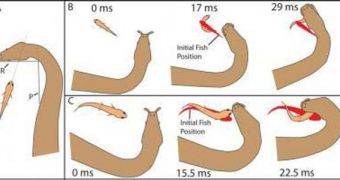A small and otherwise harmless water snake has learned a neat trick, which ensures that unsuspecting fish commit suicide via snake mouth (and die from it) a large number of times. Coiled up in a specific position, the water snake expects its prey to approach, and then scares it away with a single body move; unfortunately for the fish, the same body move sees its head inside the mouth of the snake, and then the credits start rolling. The amazing hunting technique was observed by experts at the Vanderbilt University, who used a high-speed camera to carefully analyze the sequence of actions that the snake takes in order to be able to catch its prey very easily.
What's the most amazing thing about this snake is that it does not visually watch the fish moving, so as to know where to strike. Rather, it exhibits the unusual trait of projecting the future actions of the fish, and lashes with its entire body and head to the place where it believes the fish will be after being scared, and while attempting to escape. Naturally, at times, the snake's computations are a bit off, and it launches itself over or below its target, but, on most occasions, it has a tremendous accuracy, LiveScience reports. A copy of the video can be viewed here.
“I haven't been able to find reports of any other predators that exhibit a similar ability to influence and predict the future behavior of their prey,” says VU associate professor of biological sciences Kenneth Catania of the snake's hunting behavior. “The snake forms an unusual J shape with its head at the bottom of the J when it is fishing. Then it remains completely motionless until a fish swims into the area near the hook of the J. That is when the snake strikes.” This animals is the only snake species in the world to sport tentacles on its head.
It may be that the tentacled snake profits from the fish's famous “C-shape”. When the little swimmers sense with their “pressure pads” that something is amiss in the pressure of the water around them (incoming predators tend to cause that, but not necessarily), they send a series of electrical impulses to the fish's muscles, which contract so fast, that they body is bent in the shape of the letter C, in a direction opposite to that from which the disturbance was caused. This allows the fish to begin swimming the other way and escape without having to consciously turn its body around.
And this is where the tentacled water snake is far exceedingly cunning. Because it hunts in the shape of a J, it scares the fish from one direction, but its head is actually in the other one. So, when the fish is in the C shape, it swims full speed ahead into the mouth of the snake, as all it has to do it bring its head about in the correct position to ensure the catch. However, the hunting method is not foolproof. The snake's response time is of few hundredths of a second, but that of the fish is of a few thousandths of a second, which means that the predator could easily lose its prey, if it were to get sloppy.
“Once the C-start begins, the fish can't turn back. The snake has found a way to use the fish's escape reflex to its advantage. Not all the targeted fish react with a C-start and the snake almost always misses those that don't react reflexively,” Catania explains.

 14 DAY TRIAL //
14 DAY TRIAL //